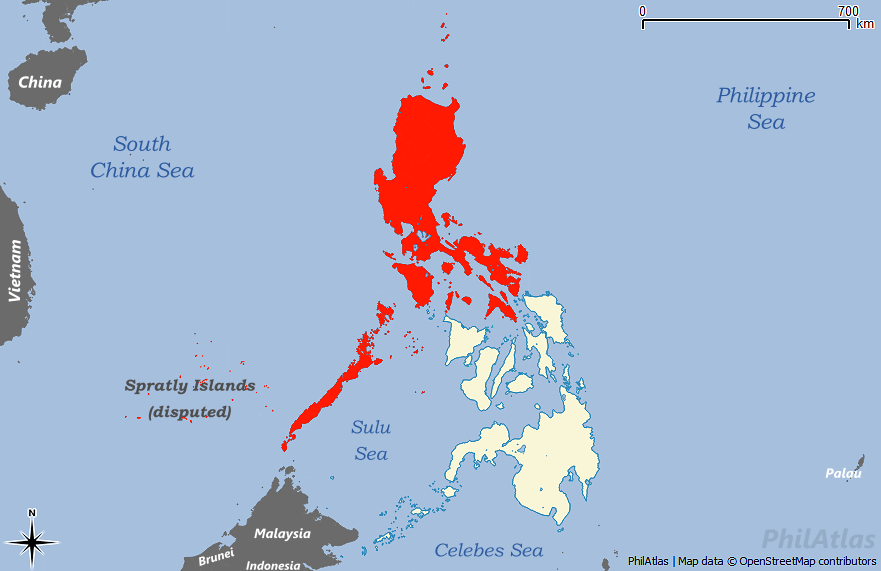Luzon
 | |
| Total local government units | |
|---|---|
| Regions | 8 |
| Provinces | 38 |
| Cities | 74 |
| Municipalities | 697 |
| Barangays | 20,518 |
| Population (2020) | 62,196,942 |
Luzon is the most populated of the three island groups making up the Philippine Archipelago. Its largest islands are the Luzon landmass, Palawan, Mindoro, Masbate, and Catanduanes.
As of 2020, the Luzon island group had a total population of 62,196,942, representing 57.04% of the entire population of the Philippines.
Location
The island group has eight (8) regions, namely, Region I (Ilocos Region), Region II (Cagayan Valley), Region III (Central Luzon), Region IV‑A (CALABARZON), MIMAROPA Region, Region V (Bicol Region), Cordillera Administrative Region (CAR), and the National Capital Region (NCR) where Manila, the nation's capital city, is located.
Luzon is bordered, clockwise from the North, by the Luzon Strait (Bashi Channel), Philippine Sea, San Bernardino Strait, Samar Sea, Visayan Sea, Jintotolo Channel, Sibuyan Sea, Tablas Strait, Sulu Sea, Balabac Strait, and the South China Sea.
map of regions
List of regions
The regions of Luzon encompass a total of thirty-eight (38) provinces, with an aggregate of seventy-three (74) cities, and 697 municipalities. The total number of barangays in the island group is 20,518.
details
| Region | Population (2020) | Regional center | Provinces | Total cities (HUC) | Total cities (ICC) | Total cities (CC) | Total mun | Total brgy |
|---|---|---|---|---|---|---|---|---|
| Ilocos Region (Region I) | 5,301,139 | San Fernando | 0 | 1 | 8 | 116 | 3,267 | |
| Cagayan Valley (Region II) | 3,685,744 | Tuguegarao | 0 | 1 | 3 | 89 | 2,311 | |
| Central Luzon (Region III) | 12,422,172 | San Fernando | 0 | 12 | 116 | 3,102 | ||
| CALABARZON (Region IV‑A) | 16,195,042 | Calamba | 0 | 19 | 122 | 4,019 | ||
| Bicol Region (Region V) | 6,082,165 | Legazpi | 0 | 1 | 6 | 107 | 3,471 | |
| National Capital Region (NCR) | 13,484,462 | Manila | 0 | 0 | 0 | 1 | 1,710 | |
| Cordillera Administrative Region (CAR) | 1,797,660 | Baguio | 0 | 1 | 75 | 1,178 | ||
| MIMAROPA Region | 3,228,558 | Calapan | 0 | 1 | 71 | 1,460 | ||
| Luzon Total | 62,196,942 | 38 | 21 | 3 | 50 | 697 | 20,518 |
Historical population
The population of Luzon grew from 4,101,516 in 1903 to 62,196,942 in 2020, an increase of 58,095,426 people over the course of 117 years. The latest census figures in 2020 denote a positive annualized growth rate of 1.68%, or an increase of 4,726,845 people, from the previous population of 57,470,097 in 2015.
Trends in population growth
| Census date | Population | Annualized Growth Rate |
|---|---|---|
| 4,101,516 | – | |
| 5,397,401 | 1.75% | |
| 8,165,778 | 2.09% | |
| 9,876,263 | 1.97% | |
| 14,061,448 | 3.16% | |
| 19,688,100 | 3.35% | |
| 22,790,274 | 2.98% | |
| 26,080,694 | 2.73% | |
| 33,357,887 | 2.49% | |
| 38,249,776 | 2.60% | |
| 42,822,686 | 2.45% | |
| 49,799,965 | 2.10% | |
| 52,362,999 | 1.84% | |
| 57,470,097 | 1.79% | |
| 62,196,942 | 1.68% |
Sources
- Historical population derived from the sum of populations of regions currently under the island group. These region populations are derived from the Philippine Statistics Authority.
- Maps utilize OpenStreetMap data available under the Open Data Commons Open Database License.